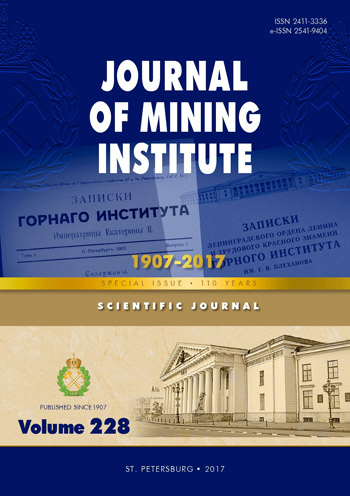Research of hard-to-recovery and unconventional oil-bearing formations according to the principle «in-situ reservoir fabric»
- 1 — Ph.D. Leading expert LLS «Gazpromneft STS»
- 2 — Head of Department LLS «Gazpromneft STS»
- 3 — Ph.D., Dr.Sci. Executive Director LLS «Gazpromneft-Angara»
- 4 — Deputy Director General LLS «Gazpromneft-Hantos»
Abstract
Currently in Russia and the world due to the depletion of old highly productive deposits, the role of hard-to-recover and unconventional hydrocarbons is increasing. Thanks to scientific and technical progress, it became possible to involve in the development very low permeable reservoirs and even synthesize oil and gas in-situ. Today, wells serve not only for the production of hydrocarbons, but also are important elements of stimulation technology, through which the technogenic effect on the formation is carried out in order to intensify inflows. In this context, the reservoir itself can be considered as a raw material for the application of stimulation technologies, and the set of wells through which it is technologically affected is a plant or a fabric whose intermediate product is the stimulated zone of the formation and the final product is reservoir hydrocarbons. Well-established methods for studying hydrocarbon deposits are limited to the definition of standard geological parameters, which are commonly used for reserves calculations (net pay, porosity, permeability, oil and gas saturation coefficient, area), but they are clearly insufficient to characterize the development possibilities using modern stimulation technologies. To study objects that are promising for the production of hydrocarbons, it is necessary to develop fundamentally new approaches that make it possible to assess the availability of resources depending on the technologies used, and to improve the methods for forecasting and evaluating the properties of the stimulated zone of the formation. «In-situ reservoir fabric» is a collective term that combines a combination of technologies, research and methodological approaches aimed at creating and evaluating a stimulated zone of the formation by applying modern methods of technogenic impact on objects containing hard-to-recover and «unconventional» hydrocarbons in order to intensify inflows from them hydrocarbons. In 2015, the company LLS Gazprom Neft adopted a corporate standard regulating a set of studies in the ideology of the «in-situ reservoir fabric» for methodological support of the pilot projects related to development of low-permeability rocks of the Bazhenov formation by creating artificial permeable zones by multi-stage hydraulic fracturing in horizontal wells. In 2016 the first wells were built and put into operation, the results of the works confirmed the expediency of transition to a new methodological basis. After two years, we can state with certainty that the new approaches have proved their effectiveness.
References
- Nenasheva M.G., Demo V.O., Zhukov V.V., Shevchuk T.N. Probabilistic Assessment of Single Well Source Rock Oil Recovery in Terms of Geological and Technological Uncertainties. SPE Russian Petroleum Technology Conference and Exhibition, 24-26 October, Moscow, Russia. URL: www.onepetro.org/search?q=SPE-182077-RU (in Russian).
- Alekseev A.D., Antonenko A.A., Zhukov V.V., Strizhnev K.V. The Differentiated Approach of the Reserves Estimation for Source Rock Formations. SPE Russian Petroleum Technology Conference and Exhibition, 24-26 October, Moscow, Russia. URL: www.onepetro.org/search?q=SPE-182074-RU (in Russian).
- Kostenko O.V. Blocking nature of distribution of high-molecular compounds of bitumoid in pore system of Bazhenov formation (West Siberian basin).Neftegazovaya geologiya. Teoriya i praktika. 2014. Vol.9. N1, p.1-13 (in Russian).
- Nemova V.D. Conditions of reservoir formation in deposits of Bazhenov within the junction of Krasnolenin arch and Frolov megadepression.Neftegazovaya geologiya. Teoriya i praktika. 2012. Vol.7. N2, p.1-14 (in Russian).
- Tolmachev E.O., Alekseev A.D., Glavnova E.N., Zhukov V.V., Shevchuk T.N. Construction of a three-dimensional geological model of the Bazhenov formation in the north-eastern side of the Krasnoleninsky arch. PRONeft'. 2017. N1(3), p.23-27 (in Russian).
- Strizhnev K.V., Zagranovskaya D.E., Zhukov V.V. Selection of promising oil and gas bearing area formations for unconventional reservoirs Bazhenov Suite. Nedropol'zovanie XXI vek. 2015. N1(51), p.46-51 (in Russian).
- Bierman S. Russia Smashes Post-Soviet Oil Supply Record as OPEC Weighs Curb / S.Bierman, S.Lee, D.Khrennikova. URL: www.bloomberg.com/news/articles/2016-09-28/russia-smashes-post-soviet-oil-supply-record-as-opec-weighs-curb
- Carroll J. Chesapeake Energy Declares «Propageddon» With Record Frack / J.Carroll, D.Wethe. URL: www.bloomberg.com/news/articles/2016-10-20/chesapeake-declares-propageddon-with-record-frack-in-louisiana
